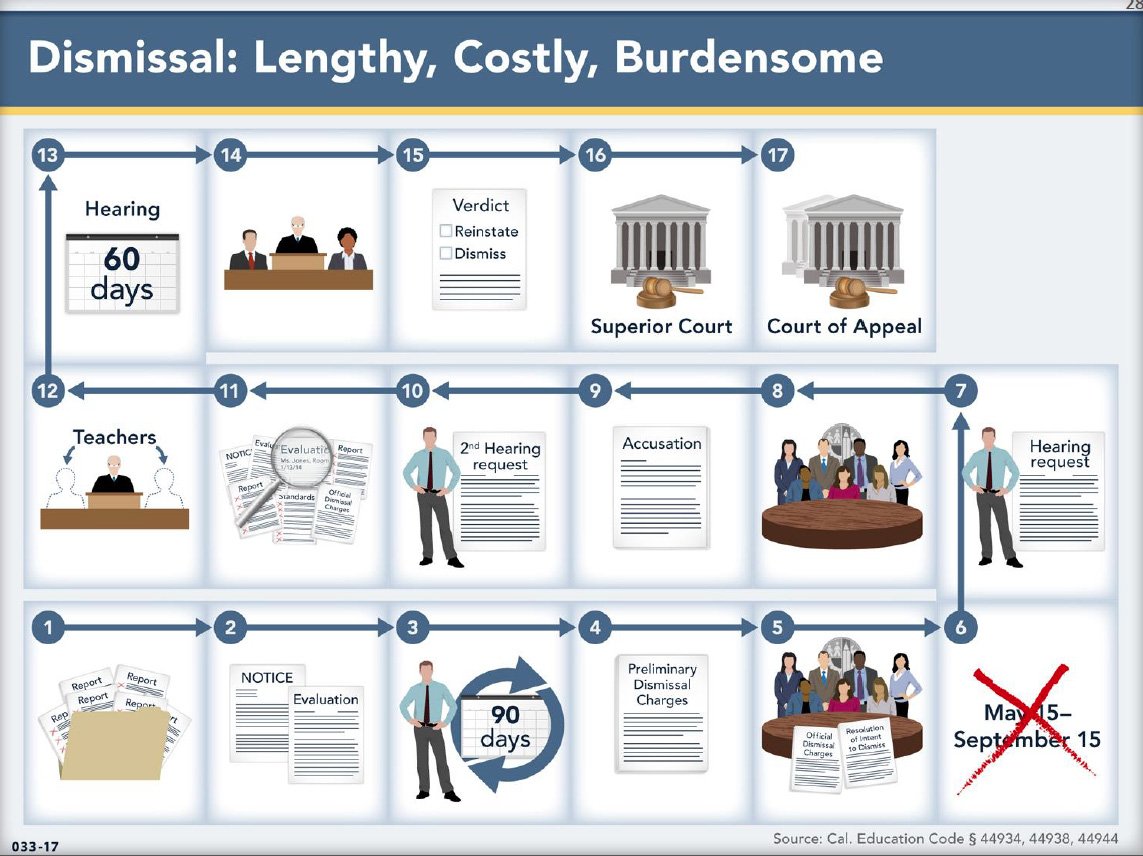Dismissal Statute
The three dismissal statutes challenged by Vergara v. California was layered on top of the reasonable due process protections already guaranteed to every public employee by the California Constitution. We believed every teacher should have due process, and the Vergara v. California lawsuit did not challenge California employees’ due process rights.
The case only challenged the laws, provided exclusively to teachers, that kept ineffective and sometimes abusive teachers in front of students year after year, with devastating lifelong consequences.
The process for dismissing a single ineffective teacher involves a borderline infinite number of steps, requires years of documentation, costs hundreds of thousands of dollars and still, rarely ever works.
Facts from the Trial
-
0.0008% Dismisses
Out of 275,000 teachers statewide, 2.2 teachers are dismissed for unsatisfactory performance per year on average, which amounts to 0.0008 percent.
-
Cost-Prohibitive Dismissals in L.A.
According to the testimony of Superintendent Dr. John Deasy, the Los Angeles Unified School District spends in excess of $250,000 to $450,000 per performance-based dismissal — a cost equivalent to hiring up to 6 new teachers.
-
Cost-Prohibitive Dismissals in Oakland
According to the testimony of Troy Christmas, director of labor relations for the Oakland Unified School District, the Oakland Unified School District spends approximately $50,000 to $400,000 per dismissal action.
-
Dismissal Discrepancy
According to the testimony of Los Angeles Unified School District’s Chief Labor Negotiator Vivian Ekchian, the dismissal of a classified employee through the Skelly due process costs only $3,400.
“Both the time and the cost are a disincentive to engage in the process at every level, not to mention the time in and of itself impacts success.”
“In order to go through the lengthy and laborious process to build a sufficient record, the teacher must be in front of children, which can often result in years of a grossly ineffective teacher being responsible for the learning of children. This was often a cost that I was not willing to bear.”
— Jonathan Raymond, Former Superintendent, Sacramento City Unified School District
“It is my opinion and it is my experience that this statute does not provide for the timely dismissal of teachers who are incompetent, who are unable to teach. And that is fundamentally what protects the quality of public schools, is having highly competent, and highly effective teachers in front of students every single day.”
— Dr. John Deasy, Superintendent, Los Angeles Unified School District
“I wish it was the case that my efficiency as a manager or my capacity to do the things I’m supposed to do would allow me to address certain issues related to personnel in an efficient way. I wish that was the case. Because if it was the case, man, I would have moved heaven and earth to do it.”
– Kareem Weaver, Executive Director, Bay Area New Leaders and Former Principal, Oakland Unified School District
-
34% of Principals Report Dismissal Process Issues
According to the National Council on Teacher Quality, 34 percent of principals surveyed in the Los Angeles Unified School District said that they did not even try to dismiss a poor-performing teacher because the process was unlikely to result in dismissal.
-
$3.5M to Dismiss Four Teachers
According to the 2010 LA Weekly report, “LAUSD’s Dance of the Lemons,” the Los Angeles Unified School District spent $3.5 million from 2000 to 2010 in efforts to dismiss seven of the district’s 33,000 employees for inadequate classroom performance. Ultimately, only four were actually let go.

